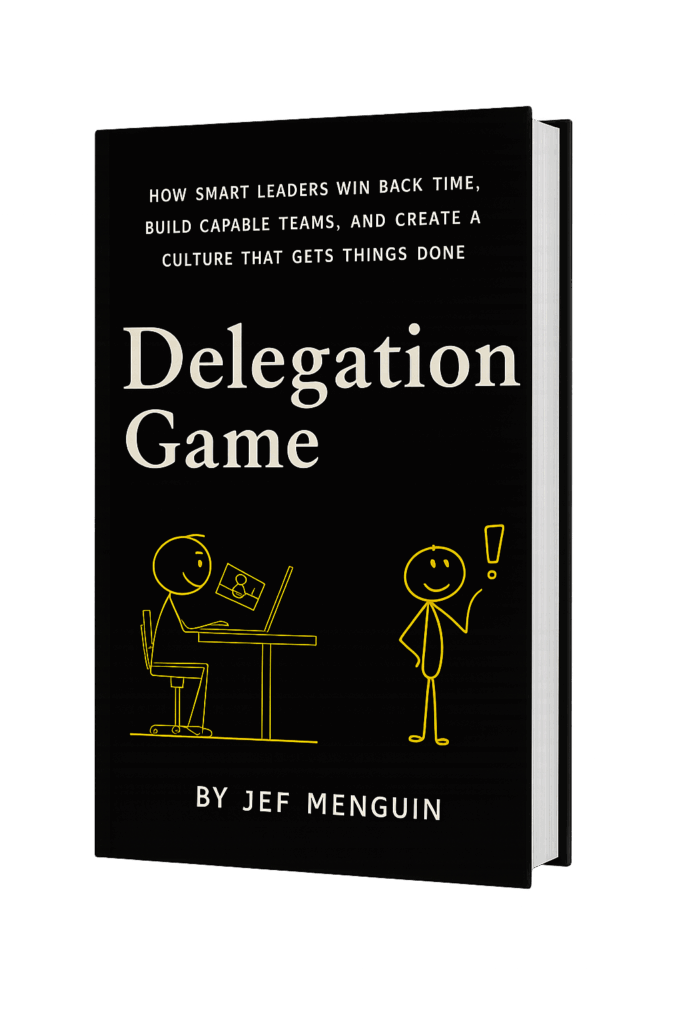You hand off a task, and deep down you’re thinking: “I hope they don’t mess this up.”
Sometimes it works. Sometimes it backfires. And when it does, you swear: “Never again. I’ll just do it myself.”
That’s not leadership. That’s gambling.
Most managers delegate by habit (“I’ll just give this to whoever’s free”) or by hope (“They’ll figure it out”). Both lead to uneven results.
Delegation should never be left to luck. It needs a map.
That’s where the Delegation Matrix comes in.
Why Risks vs Readiness Matters
In The Delegation Game, I wrote:
“Delegation fails when leaders ignore the two invisible weights: the risk of the task and the readiness of the person. When you match them well, delegation clicks. When you mismatch, chaos follows.”
The frustration you feel when work comes back wrong? It’s usually because you skipped this step. You didn’t assess risk or readiness. You just handed it over.
The Story of a Costly Mismatch
Anna, a project manager, once gave a new intern the job of calling key suppliers to negotiate prices. She thought, “It’s just phone calls—simple enough.”
But this was high-risk work. A wrong word could damage relationships worth millions. The intern was low-readiness: no experience, no confidence, no knowledge of supplier history.
The result? One supplier walked away insulted. Another threatened to pull out of a contract. Anna had to scramble to repair the damage.
The mistake wasn’t the intern’s. It was Anna’s. She mismatched risk and readiness.
A Better Match
Contrast that with Miguel. He needed to prepare a detailed operations report. It was important but low-risk—the worst-case scenario was a few wrong numbers that could be fixed.
He gave the task to a junior staff member who had decent Excel skills but little business context. Miguel used the “Direct & Demo” style—he showed them how to structure the first part, then let them complete the rest.
The report came back solid. The junior staff learned. Miguel gained time. That’s how delegation clicks when the match is right.
The Two Axes That Change Everything
The Delegation Matrix has two simple axes:
- Risk: What’s the potential damage if this goes wrong?
- High risk = impacts clients, finances, brand reputation.
- Low risk = internal trial, fixable mistakes, learning opportunities.
- Readiness: How prepared is this person?
- High readiness = strong skills, relevant experience, proven judgment.
- Low readiness = new, untrained, or uncertain.
Plot the task and the person across these two axes, and you’ll know the right delegation style to use.
The Four Styles of Delegation
1. Direct & Demo (Low Readiness + High Risk)
Think of this as “training wheels.” You keep more control because the stakes are high. You demonstrate, guide, and let them try in a safe portion.
Example: Walking a new hire through the first client email before letting them draft their own.
2. Assign & Autonomy (Low Readiness + Low Risk)
This is for learning opportunities. You assign a small, low-stakes task and let them figure it out. Mistakes here are safe and valuable for growth.
Example: Letting a junior member draft an internal memo you can review before it goes public.
3. Co-Pilot (High Readiness + High Risk)
Here, you sit beside them. You trust their skill, but the stakes demand collaboration. You’re both in the cockpit.
Example: Having your senior analyst lead a pitch presentation while you handle key objections.
4. Owner with Boundaries (High Readiness + Low Risk)
This is the sweet spot of true delegation. You give full ownership, set boundaries, and step back.
Example: Telling a senior staff member, “This project is yours. Here are the three non-negotiables. Beyond that, you decide.”
Why Matching Makes Execution Click
When risk and readiness are mismatched, frustration explodes.
- High risk + low readiness = disaster.
- Low risk + high readiness = boredom.
But when you match correctly, magic happens:
- The right tasks go to the right people.
- Learning happens where it’s safe.
- Confidence grows where it’s needed.
- Results multiply without chaos.
This is why the Delegation Matrix is non-negotiable. It turns delegation from guesswork into a reliable play.
What’s at Stake
Ignore this step, and you’ll face the same cycle many managers do:
- Work comes back wrong.
- You redo it.
- You stop trusting your team.
- They stop growing.
But use the matrix, and you start seeing the opposite:
- Right people on the right tasks.
- Mistakes become learning, not disasters.
- Your team scales with you, not against you.
As The Delegation Game reminds us:
“Delegation without a map is delegation by luck. And luck runs out.”
A New Direction
Before handing off your next task, pause and ask:
- How risky is this task if it goes wrong?
- How ready is this person for the task?
- Which quadrant of the Delegation Matrix does this land in?
Then pick the style that matches. That five-second pause could save you five hours of rework—and five days of frustration.
Your Move
Here’s your challenge:
- Take three tasks you plan to delegate this week.
- For each, rate the risk (high/low) and the person’s readiness (high/low).
- Place them on the matrix.
- Choose the delegation style accordingly.
Try it. Watch how different the outcomes feel when you match the play to the situation.
Where We Go Next
This was Step 2 of the 7-Step Delegation Play. Coming up:
- Step 3: Set Boundaries – The Rules of the Game.
- Step 5: Agree on Check-Ins – Oversight Without Hovering.
- Step 6 & 7: Document and Debrief – Learning and Upgrading Delegation.
Once you see the map, you’ll never delegate blindly again.
👉 I guide leaders to move beyond plans into practice. My book, The Delegation Game, and my consulting work help managers align strategy, people, and culture.





